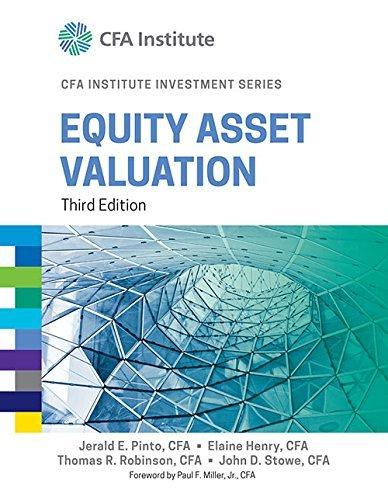The following two passages are closely based on the valuation discussions of actual companies in two actual
Question:
The following two passages are closely based on the valuation discussions of actual companies in two actual short research notes. The dates and company names used in the passages, however, are fictional.
A. A t a recent multiple of 6.5, our earnings per share multiple for 2012, the shares were at a discount to our projection of 14 percent growth for the period … MXI has two operating segments. … In valuing the segments separately, employing relative acquisition multiples and peer mean values, we found fair value to be above recent market value. In addition, the shares trade at a discount to book value (0.76). Based on the value indicated by these two valuation metrics, we view the shares as worth holding. However, in light of a weaker economy over the near term, dampening demand for MXI’s services, our enthusiasm is tempered.
B. A lthough TXI outperformed the overall stock market by 20 percent since the start of the year, it definitely looks undervalued as shown by its low multiples …
Although some of the concepts mentioned in the two passages may not yet be familiar, you can begin to assess the two reporting efforts.
Passage A communicates the analysis awkwardly. The meaning of “the shares were at a discount to our projection of 14 percent growth for the period” is not completely clear. Presumably the analyst is projecting the earnings growth rate for 2012 and stating that the P/E is low in relation to that expected growth rate. The analyst next discusses valuing MXI as the sum of its divisions. In describing the method as “employing relative acquisition multiples and peer mean values,” the analyst does not convey a clear picture of what was done. It is probable that companies similar to each of MXI’s divisions were identified; then the mean or average value of some unidentified multiple for those comparison companies was calculated and used as the basis for valuing MXI. The writer is vague, however, on the extent of MXI’s undervaluation. The analyst states that MXI’s price is below its book value (an accounting measure of shareholders’ investment) but draws no comparison with the average price-to-book value ratio for stocks similar to MXI, for example. (The price-to-book ratio is discussed in a later reading.) Finally, the verbal summation is feeble and hedged. Although filled with technical verbiage, Passage A does not communicate a coherent valuation of MXI.
In the second sentence of Passage B, by contrast, the analyst gives an explicit valuation of TXI and the information needed to critique it. The reader can also see that €3.08, which is elsewhere stated in the research note as the target price for TXI , implies the stated price appreciation potential for TXI [(€3.08/€2.25) – 1, approximately 37 percent]. In the first sentence in Passage B, the analyst gives information that might support the conclusion that TXI is undervalued, although the statement lacks strength because the analyst does not explain why the P/E is “low.” The verbal summary is clear.
Using less space than the analyst in Passage A, the analyst in Passage B has done a better job of communicating the results of his valuation.
Step by Step Answer:






